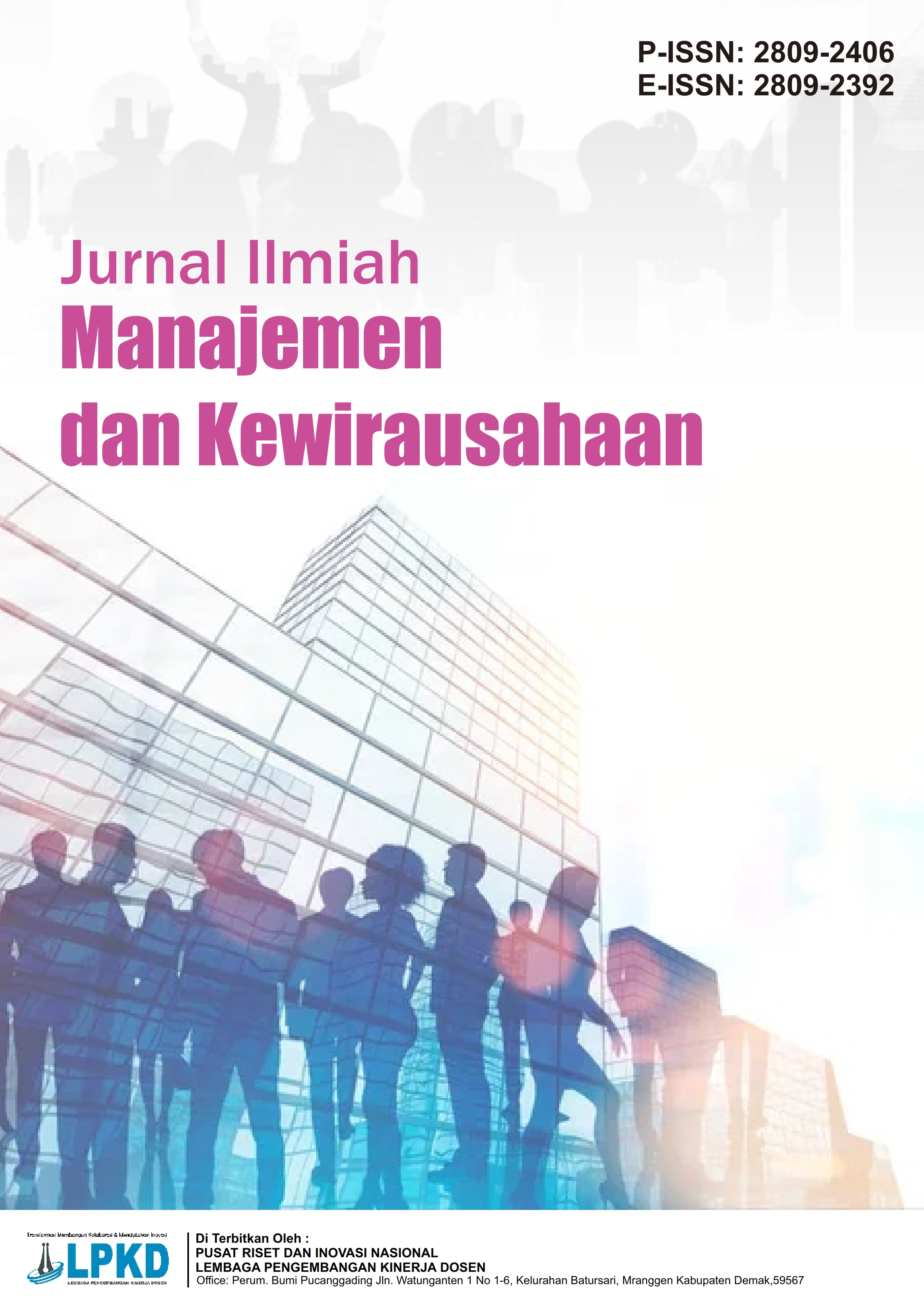Evaluasi Dampak Pembangunan Kawasan Ekonomi Khusus terhadap Pertumbuhan Ekonomi di Provinsi Kepulauan Riau
DOI:
https://doi.org/10.55606/jimak.v4i1.5004Keywords:
Difference-in-Differences (DiD), Economic Growth, Impact Evaluation, Special Economic Zones (SEZs)Abstract
Special Economic Zones (SEZs) are designated areas within Indonesia established to perform specific economic functions and granted special incentives. The Indonesian government promotes equitable growth through various strategies, including SEZ development. The Riau Islands Province (Kepri) hosts the highest number of SEZs in the country. This decision reflects strategic considerations, as the province offers strong potential for SEZ expansion. Its geographic advantage along major international shipping routes and near Singapore and Malaysia makes Kepri a key hub for national and regional economic growth. Additionally, the province benefits from relatively developed infrastructure and strong local government commitment to SEZ support. This study evaluates the impact of SEZs on economic growth in the Riau Islands Province using a Difference-in-Differences (DiD) linear regression approach at the district/city level. The results show that, after SEZs became operational, districts/cities with SEZs recorded an average economic growth rate 0.135 percentage points higher than those without SEZs.
References
Aggarwal, A. (2022). Special economic zones in the Indonesia-Malaysia-Thailand growth triangle. Asian Development Bank.
Badan Pusat Statistik Provinsi Kepulauan Riau. (2024). Produk Domestik Regional Bruto per Kapita atas dasar harga konstan 2010 menurut kabupaten/kota di Provinsi Kepulauan Riau (ribu rupiah). Diakses pada 2 Mei 2025.
Dewan Nasional Kawasan Ekonomi Khusus. (2021). Laporan perkembangan kawasan ekonomi khusus tahun 2021. Jakarta.
Dubinina, E. (2022). Impact of special economic zones on domestic market: Evidence from Russia. Post-Communist Economies, 35(1), 82–99. https://doi.org/10.1080/14631377.2022.2138154
Galal, E. (2021). Special economic zones and industrial parks in South Asia: An assessment of their regulatory structures. World Bank Group.
Hardaker, S. (2020). Embedded enclaves? Initial implications of development of special economic zones in Myanmar. The European Journal of Development Research, 32(2), 404–430. https://doi.org/10.1057/s41287-020-00271-2
Khandker, S. R., Koolwal, G. B., & Samad, H. A. (2010). Handbook on impact evaluation: Quantitative methods and practices. The World Bank.
Maftuhah, T. (2017). Dampak pembangunan kawasan ekonomi khusus (KEK) terhadap pertumbuhan usaha mikro kecil dan menengah (UMKM) di Tanjung Lesung Kabupaten Pandeglang Provinsi Banten (Skripsi, Universitas Sultan Ageng Tirtayasa). Serang: Fakultas Ilmu Sosial dan Ilmu Politik.
Mahri, A. J. W., Cupian, A., Arif, M. N. R., Arundina, T., Widiastuti, T., Mubarok, F., Fajri, M., Azizon, & Nurasyiah, A. (2021). Ekonomi pembangunan Islam. Deepublish.
Moberg, L. (2017). The political economy of special economic zones: Concentrating economic development. https://doi.org/10.4324/9781315298955
Muzwardi, A. (2020). Analisa collaborative governance dalam menarik investasi asing kawasan Free Trade Zone Bintan. Jurnal PIR: Power in International Relations, 3(2), 126. https://doi.org/10.22303/pir.3.2.2019.126139
Nazarczuk, J. M., & Umiński, S. (2018). The impact of special economic zones on export behaviour: Evidence from Polish firm-level data. E & M: Ekonomie a Management, 21(3), 4–22.
Possebom, V. (2017). Free Trade Zone of Manaus: An impact evaluation using the synthetic control method. Revista Brasileira de Economia, 71(2), 217–231.
Prasiska, G., Ramadhani, K. N., Ningsih, P. W., Silverius, R., Andini, S., & Sembiring, T. (2023). Analisis peran Indonesia dalam kerjasama dengan,1(5), 282–291.
Riesfandiari, I., Setyawan, B., & Wahyudi, I. T. (2023). Dampak kawasan ekonomi khusus (KEK) Sei Mangkei terhadap perekonomian di Kabupaten Simalungun. Jurnal Perspektif Bea dan Cukai, 7(1), 147–170. https://doi.org/10.31092/jpbc.v7i1.2131
Sapriadi, & Hisbullah. (2015). Analisis penentuan sektor unggulan perekonomian Kabupaten Bulukumba. Jurnal Iqtisaduna, 1(1), 75. Diakses pada 30 April 2025, http://www.journal.uinalauddin.ac.id/index.php/Iqtisaduna/article/download/1155/1121
Setiawan, K., Lusiantoro, L., & Sahadewo, G. A. (2020). Evaluasi proses bisnis dan dampak ekonomi Pusat Logistik Berikat Indonesia. Laporan Penelitian.
Setya, L. (2022). Online training difference in differences method for policy evaluation (using STATA). RISED.
Tang, K. (2022). The political economy of special economic zones: The cases of Ethiopia and Vietnam. Review of International Political Economy, 30(5), 1957–1983. https://doi.org/10.1080/09692290.2022.2152073
Taufiqurrahman, T., & Khoirunurrofik, K. (2023). Special economic zones (SEZs) impact on poverty in Indonesia. Jurnal Perencanaan Pembangunan: The Indonesian Journal of Development Planning, 7(2), 231–249. https://doi.org/10.36574/jpp.v7i2.473
Undang-Undang Republik Indonesia Nomor 39 Tahun 2009 tentang Kawasan Ekonomi Khusus.
Wang, J. (2013). The economic impact of special economic zones: Evidence from Chinese municipalities. Journal of Development Economics, 101(1), 133–147. http://dx.doi.org/10.1016/j.jdeveco.2012.10.009
Wang, Z., Yang, Y., & Wei, Y. (2022). Has the construction of national high-tech zones promoted regional economic growth? Empirical research on prefecture-level cities in China. Sustainability, 14(10), 6349. https://doi.org/10.3390/su14106349
Warr, P., & Menont, J. (2016). Cambodia’s special economic zone. Journal of Southeast Asian Economies, 33(3), 273–290.
Widianto, Y. W., & Yudhistira, M. H. (2021). Special economic zones and regional economic development: Empirical evidence from Sei Mangkei SEZ. Jurnal Anggaran dan Keuangan Negara Indonesia, 3(2).
Downloads
Published
How to Cite
Issue
Section
License
Copyright (c) 2025 Jurnal Ilmiah Manajemen dan Kewirausahaan

This work is licensed under a Creative Commons Attribution-NonCommercial-ShareAlike 4.0 International License.







